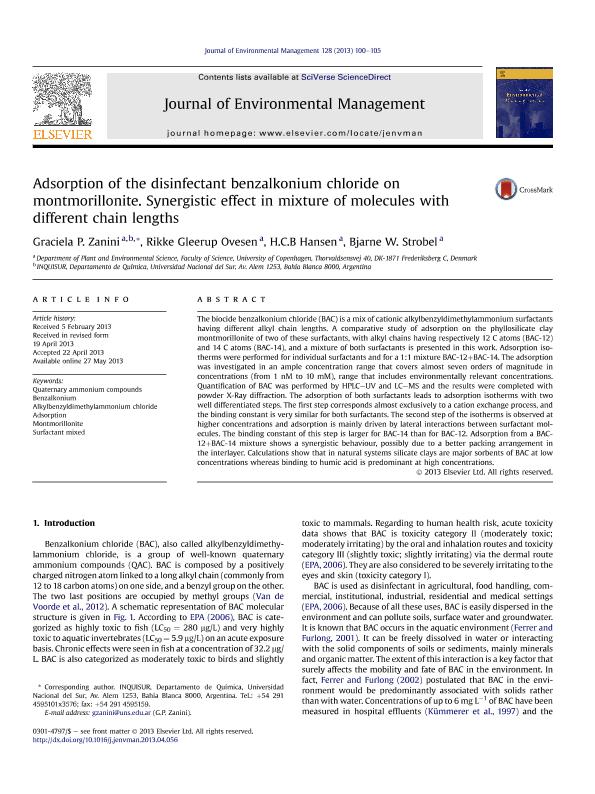Mostrar el registro sencillo del ítem
dc.contributor.author
Zanini, Graciela Pilar

dc.contributor.author
Gleerub Ovensen, Rikke
dc.contributor.author
Hansen, H. C. B.
dc.contributor.author
Strobel, Bjarne W.
dc.date.available
2016-04-28T14:53:17Z
dc.date.issued
2013-04
dc.identifier.citation
Zanini, Graciela Pilar; Gleerub Ovensen, Rikke; Hansen, H. C. B.; Strobel, Bjarne W.; Adsorption of the disinfectant benzalkonium chloride on montmorillonite: Synergistic effect in mixture of molecules with different chain lengths; Elsevier; Journal of Environmental Management; 128; 4-2013; 100-105
dc.identifier.issn
0301-4797
dc.identifier.uri
http://hdl.handle.net/11336/5419
dc.description.abstract
The biocide benzalkonium chloride (BAC) is a mix of cationic alkylbenzyldimethylammonium surfactants having different alkyl chain lengths. A comparative study of adsorption on the phyllosilicate clay montmorillonite of two of these surfactants, with alkyl chains having respectively 12 C atoms (BAC-12) and 14 C atoms (BAC-14), and a mixture of both surfactants is presented in this work. Adsorption isotherms were performed for individual surfactants and for a 1:1 mixture BAC-12+BAC-14. The adsorption was investigated in an ample concentration range that covers almost seven orders of magnitude in concentrations (from 1 nM to 10 mM), range that includes environmentally relevant concentrations. Quantification of BAC was performed by HPLC–UV and LC–MS and the results were completed with powder X-Ray diffraction. The adsorption of both surfactants leads to adsorption isotherms with two well differentiated steps. The first step corresponds almost exclusively to a cation exchange process, and the binding constant is very similar for both surfactants. The second step of the isotherms is observed at higher concentrations and adsorption is mainly driven by lateral interactions between surfactant molecules. The binding constant of this step is larger for BAC-14 than for BAC-12. Adsorption from a BAC-12+BAC-14 mixture shows a synergistic behaviour, possibly due to a better packing arrangement in the interlayer. Calculations show that in natural systems silicate clays are major sorbents of BAC at low concentrations whereas binding to humic acid is predominant at high concentrations.
dc.format
application/pdf
dc.language.iso
eng
dc.publisher
Elsevier

dc.rights
info:eu-repo/semantics/openAccess
dc.rights.uri
https://creativecommons.org/licenses/by-nc-nd/2.5/ar/
dc.subject
Benzalkonium
dc.subject
Quaternary Ammonium Compounds
dc.subject
Montmorillonite
dc.subject
Surfactant Mixed
dc.subject.classification
Geoquímica y Geofísica

dc.subject.classification
Ciencias de la Tierra y relacionadas con el Medio Ambiente

dc.subject.classification
CIENCIAS NATURALES Y EXACTAS

dc.title
Adsorption of the disinfectant benzalkonium chloride on montmorillonite: Synergistic effect in mixture of molecules with different chain lengths
dc.type
info:eu-repo/semantics/article
dc.type
info:ar-repo/semantics/artículo
dc.type
info:eu-repo/semantics/publishedVersion
dc.date.updated
2016-05-06 15:52:43.262787-03
dc.journal.volume
128
dc.journal.pagination
100-105
dc.journal.pais
Países Bajos

dc.journal.ciudad
Amsterdam
dc.description.fil
Fil: Zanini, Graciela Pilar. Consejo Nacional de Investigaciones Científicas y Técnicas. Centro Científico Tecnológico Bahía Blanca. Instituto de Química del Sur; Argentina. Universidad de Copenhagen; Dinamarca
dc.description.fil
Fil: Gleerub Ovensen, Rikke. Universidad de Copenhagen; Dinamarca
dc.description.fil
Fil: Hansen, H. C. B.. Universidad de Copenhagen; Dinamarca
dc.description.fil
Fil: Strobel, Bjarne W.. Universidad de Copenhagen; Dinamarca
dc.journal.title
Journal of Environmental Management

dc.relation.alternativeid
info:eu-repo/semantics/altIdentifier/url/http://www.sciencedirect.com/science/article/pii/S030147971300306X
dc.relation.alternativeid
info:eu-repo/semantics/altIdentifier/doi/http://dx.doi.org/10.1016/j.jenvman.2013.04.056
Archivos asociados
